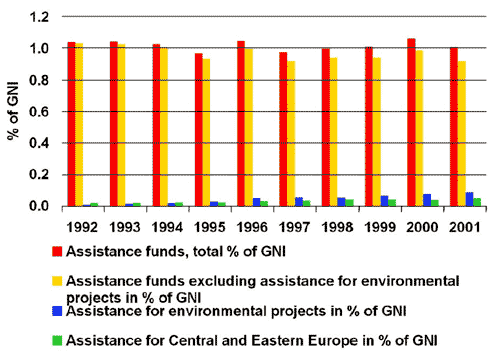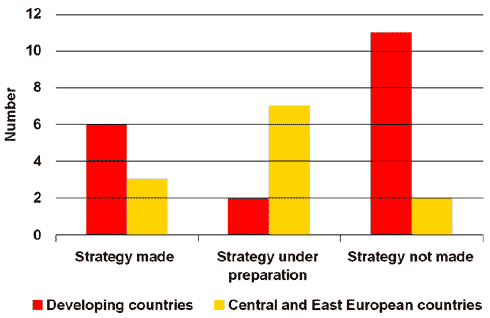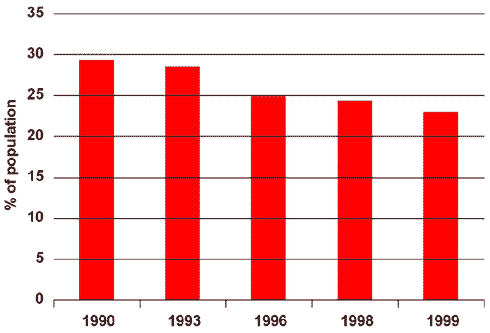Indicator Report
8. Denmark's international activities
Objectives
Denmark's vision for regional and global sustainable development foresees a Europe and a world enjoying economic progress, increased welfare and better environmental protection. It encompasses a world market with free trade, based on high environmental and social standards coupled with respect for human rights, democratisation, openness and administrative accountability.
Through both its foreign and environment policy, Denmark will work actively to promote international endeavours. Danish international assistance is well in excess of the UN target of 0.7 per cent of GNI. Denmark considers it important to maintain coherence between development, environment, and trade policy.
Denmark favours a strong global structure aimed at promoting all the elements of global sustainable development, including a structure that furthers international environmental cooperation and regulation. Denmark will work towards a global deal on sustainable development and global partnership.
Developments - a summary
With its extensive international efforts, Denmark lives up to its national visions on contributing to combating poverty in the world. The Danish objectives for promoting global, sustainable development are closely linked to the international development targets set by the UN, and they support these targets.
During the period 1999 to 2001, Denmark contributed approximately 1 per cent of its GNI every year, which is far more than the UN target of 0.7 per cent of the GNI. In 2001, environmental assistance accounted for approximately 0.09 per cent of the GNI, and this figure has increased during the years 1999-2001.
A small majority of the countries receiving assistance from Denmark (development assistance; environmental assistance for developing countries and Central and Eastern European countries) have followed the call issued by the UN Conference for Environment and Development (UNCED) in 1992, encouraging all countries to prepare national strategies for sustainable development.
Perspectives for development of indicators
As regards Danish assistance to Central and Eastern European Countries and developing countries, work is being carried out to further develop an indicator system for the results of this assistance. This system will be based on indicators which the recipient countries themselves have an interest in calculating, and will be selected in close collaboration with the partner country. Ownership of the data will fall to the recipient country concerned.
Work is carried out on developing indicators, at national and international levels. One challenge is to ensure consistent quality and comparability of data within and across national boundaries, as well as the efforts to arrive at international agreement on these issues. The work carried out within the OECD on establishing indicators which can be used as a basis for the annual economic reviews are expected to be completed (at a pilot stage) in time to contribute to the Johannesburg Summit on Sustainable Development in August/September 2002.

Indicator 8.1:
Assistance funds as a percentage of GNI, in total and analysed between development and
environmental assistance, and assistance to neighbouring countries
Source: The Ministry for Foreign Affairs and the Environmental Protection Agency
This indicator elucidates Denmark's international efforts. The figure presents an account of the development in assistance in accordance with the calculation rules used by the OECD development committee, the DAC. The figure also shows the relative funds spent on environmental assistance (as a percentage of GNI) and other development assistance (total assistance excluding environmental assistance) as a percentage of GNI. Environmental assistance can be funded via official development assistance (of which 15 per cent is allocated to projects for environmental improvement) as well as via the MIFRESTA (Environment Peace and Stability Fund) framework.
During the period 1999 to 2001, Denmark contributed approximately 1 per cent of its GNI every year, which is far more than the UN target of 0.7 per cent of the GNI. In 2001, environmental aid accounted for approximately 0.08 per cent of GNI, and this figure has increased during the years 1999-2001.
With its extensive international efforts, Denmark lives up to its national visions on contributing to combating poverty in the world. The Danish objectives for promoting global, sustainable development are closely linked to the international development targets set by the UN, and they support these targets.

Indicator 8.2:
Number of developing countries and Central and Eastern European countries which have
national strategies for sustainable development and which receive assistance from Denmark.
Source: The Ministry of Foreign Affairs
This indicator shows the number of countries receiving assistance from Denmark (development assistance; environmental assistance for developing countries and Central and Eastern European countries) which have followed the call issued by the UN Conference for Environment and Development (UNCED) in 1992, encouraging all countries to prepare national strategies for sustainable development. The special UN General Assembly in 1997 concerning follow-up to the UNCED (Rio +5) established 2002 as the target year for preparation of the strategies. The OECD target is that implementation of the strategies is ongoing in 2005.
The indicator shows that the Central and Eastern European countries have made considerably more progress on preparing the strategies than the developing countries. This is undoubtedly because the Central and Eastern European countries have a great deal more resources at their disposal. Denmark directly supports preparation of the strategies in Uganda and Vietnam.
The value of these strategies as tools for implementation of sustainable development will very much depend on the weight attributed to them at the World Summit on Sustainable Development in Johannesburg in 2002, and on the decisions made by the Summit regarding future work on sustainable development. As regards developing countries, it is crucial that the strategies be incorporated in the national strategies for combating poverty (PRSP- Poverty Reduction Strategy Papers). Denmark supports this work in the Danish programme collaboration countries.

Indicator 8.3:
Number of people who live on less than USD 1 a day
Source: 2002 World Development Indicators, the World Bank
With the Millennium Declaration in 2000, the UN Member States committed to a number of international development targets, including targets for sustainable development. The Danish objectives for promoting global, sustainable development are closely linked to the international development targets set by the UN, and they support these targets. The UN, the OECD, and the World Bank have joined forces to establish a number of indicators, of which indicator 8.3 is shown as a background indicator for objectives concerning poverty reduction and sustainable development. The indicator for absolute poverty shows the percentage of people who live on less than USD 1 a day. The UN has adopted an objective which stipulates that the number of people living in absolute poverty, i.e. on less than USD 1 a day, must be halved during the period 1990 to 2015. This is why the time statistics commence in 1990.
There has been a decrease in the relative percentage of people living in absolute poverty on a global level, from 29 per cent in 1990 to 23 per cent in 1999. This is to say that developments during the 1990s were positive. The indicator does not, however, reflect large variations between regions, countries, and even within individual countries. Most of the progress made throughout the 1990s was occasioned by increased growth in a number of Asian countries, where the number of poor people fell significantly. At the same time, the number of poor people rose in other Asian countries and in other regions.
The figure reflects total global efforts made to combat poverty. The World Bank estimates that economic growth per capita in developing countries must increase by an average of 3.6 per cent per year if the number of poor people is to be successfully halved by 2015. This is to say that there is a need for a considerable boost in economic growth when compared to the average rate of growth in the 1990s, which was 1.6 per cent per capita per year on average.